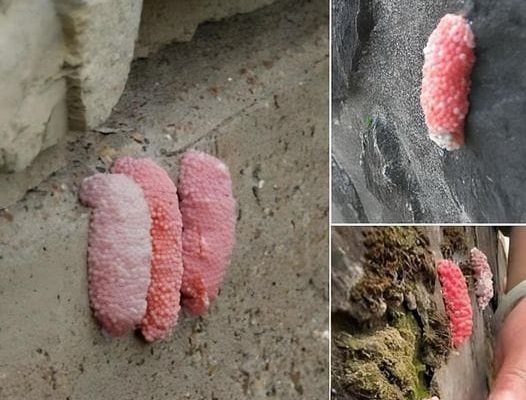e careful if you see these little pink eggs on a wall. It is the bad sign for your house
The appearance of the clusters of little, brilliant pink eggs that you have discovered in your garden may give the impression that they are innocuous or even festive. However, you should be cautious since these pink eggs are actually the product of the invasive apple snail, a species that poses a significant risk to the ecosystems of the surrounding area. These snails have expanded all over the world, wreaking havoc on plants, crops, and natural ecosystems wherever they establish themselves. They originated in South America and have since moved to other parts of the world.
When it comes to freshwater snails, the Apple Snail is a giant.
The apple snail, which is a type of freshwater mollusk, is far larger than the variety of snails that are normally found in gardens. The apple snail is a sight that is both magnificent and scary because to its shell, which may reach a width of up to 10 centimeters. They flourish in damp areas such as ponds, lakes, and swamps, where they are able to quickly proliferate, particularly in regions that are warmer.

Clusters of pink or orange eggs, each measuring around two to three millimeters in diameter, are laid by apple snails. This is a testament to the prolific reproductive behaviors that make the apple snail such a successful and hazardous intruder. These eggs frequently emerge in clusters of 400 to 600, which is a tribute to the successful invasion.
Why are apple snails such a ubiquitous pest?
According to the World Wildlife Fund, apple snails are among the top 100 most invasive foreign species in the world. They have an incredible capacity to adjust to new situations, breed, and prosper in a variety of settings, which is in part due to the effects of global warming. They were formerly confined to the warm and humid regions of South America; nevertheless, they have since spread to several locations in North America, Europe, and Asia, where they are now well-established in a number of various nations.
Not only are these snails able to blend in with their surroundings, but they also manage to dominate them. Apple snails engage in a ravenous eating habit, consuming a diverse assortment of plant species. Apple snails are known for wreaking havoc on rice fields and generating considerable agricultural losses in certain locations, such as Southeast Asia, where they were first introduced in the 1980s. The fast reproduction and resiliency of these organisms make it possible for them to readily outcompete local species for resources, which can result in a reduction in biodiversity.
There are telltale signs of an invasion, and these are apple snail eggs.
Apple snails are easily identifiable by the clusters of pink eggs that they lay, which are one of the most obvious signs of their presence. Typically, these eggs are discovered on leaves, branches, and other elevated surfaces that are located close to water. This provides them with the best possible chance of surviving and hatching. Although apple snail eggs contain toxins that make them less enticing to birds and other possible predators, the vivid coloration serves as a warning sign for birds and other prospective predators.
If you come upon these eggs, it is imperative that you take immediate action. Once the snails hatch, they have the capacity to rapidly spread and begin causing damage. Each cluster of eggs has the potential to create hundreds of snails. Residents of countries where apple snails have grown established are frequently encouraged by local authorities to report any sightings of these eggs in order to assist in the control of the proliferation of the species.
In what areas have apple snails been found, and what kinds of damage do they cause?
The adaptability of apple snails has allowed them to move all the way beyond the South American settings in which they were originally found. Numerous states in North America, including Florida, Texas, and California, have already established populations of these organisms. In Asia, they have become a widespread pest in rice paddies, although in Europe, they have been reported in nations such as Spain and France. The eggs of apple snails were found in France in 2018, close to the town of Fréjus, which prompted quick steps to manage the pest. However, it turned out that even these protective measures were not enough to completely stop their spread.

Apple snails are responsible for a significant amount of damage that is widespread. Large quantities of aquatic plants are consumed by them. These plants are essential to the upkeep of healthy ecosystems because they supply other organisms with a habitat, oxygen, and food. Apple snails disrupt the equilibrium of local ecosystems by consuming these plants, which has repercussions for a variety of factors, including the quality of the water and the number of fish populations. It is possible for them to destroy crops in agricultural settings due to their insatiable appetite for new shoots, which can result in severe financial losses for farmers.
Apple snails are a problem that needs to be addressed.

It is necessary to make a concerted effort in order to restrict the spread of apple snails because of their high resistance to disease and their high rate of reproduction. The sale of apple snails as pets has been prohibited in many regions due to the fact that aquarists frequently release these snails into the wild from their aquariums. Nevertheless, more precautions are required in order to stop the further development of the disease and to lessen the damage that it causes.
The following are some methods that can be utilized to manage apple snails:
You can report sightings of apple snails or their eggs by calling one of the many hotlines or visiting one of the many websites that have been established in several countries. When it comes to curbing their spread, early detection is essential.
Manual Removal: In certain regions, the local authorities support the removal of apple snail eggs through the use of manual methods. In order to accomplish this, the clusters must be scraped off of surfaces and disposed of in an appropriate manner. To protect yourself from any potential poisons, you should always use gloves when handling apple snail eggs.
Biological Controls: Researchers are investigating the possibility of utilizing natural predators or parasites to prevent apple snail populations from growing out of control. On the other hand, these steps are still in the experimental phase, and they are being closely watched to ensure that they do not have any unforeseen effects on the environment.
The public can be made aware of the dangers posed by invasive species such as apple snails by the implementation of education initiatives such as these. There are a lot of individuals who, until it is too late, are unaware of the potential damage that these creatures might cause themselves.
Reasons Why Gardeners Should Be Concerned About Apple Snail Invasions
The idea that these intruders could take over your garden could be worrisome for you if you are someone who enjoys gardening a great deal. Apple snails have the potential to rapidly exterminate the plant life in your yard, particularly if you have ponds or other water elements in your landscape. Once they have established themselves, it can be difficult to eradicate them, which is why it is essential to take prompt action if you see clusters of their pink eggs.

These eggs, in addition to being unsightly, indicate a wider threat to the health of your garden as well as the ecology that is located in the surrounding area. Native plant species are frequently ravaged in areas where apple snails have gotten established, which has a negative impact on the integrity of the entire food chain. The act of reporting and removing these eggs is a little but significant contribution that you can make to the protection of the ecosystem in your immediate vicinity from further damage.
It is essential to maintain vigilance in order to contain the threat posed by the apple snail.
It is possible that the appearance of pink eggs in your garden will be shocking; nevertheless, if you are able to identify them as the warning sign of an invasive species, you will be able to take prompt and effective action. Apple snails and their eggs are more than simply a nuisance; they are a true threat to the natural ecosystems, agriculture, and biodiversity that are found all over the world.
You can help prevent the spread of these invaders and protect the health of your garden as well as the ecosystem in your area by remaining attentive, reporting any sightings you come across, and gaining a knowledge of the risks associated with these invaders. Always keep in mind that it is up to each and every one of us to do all we can to protect the ecosystems of the globe, one cluster of pink eggs at their own pace.



